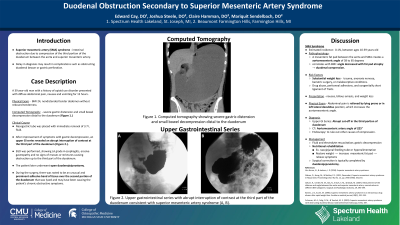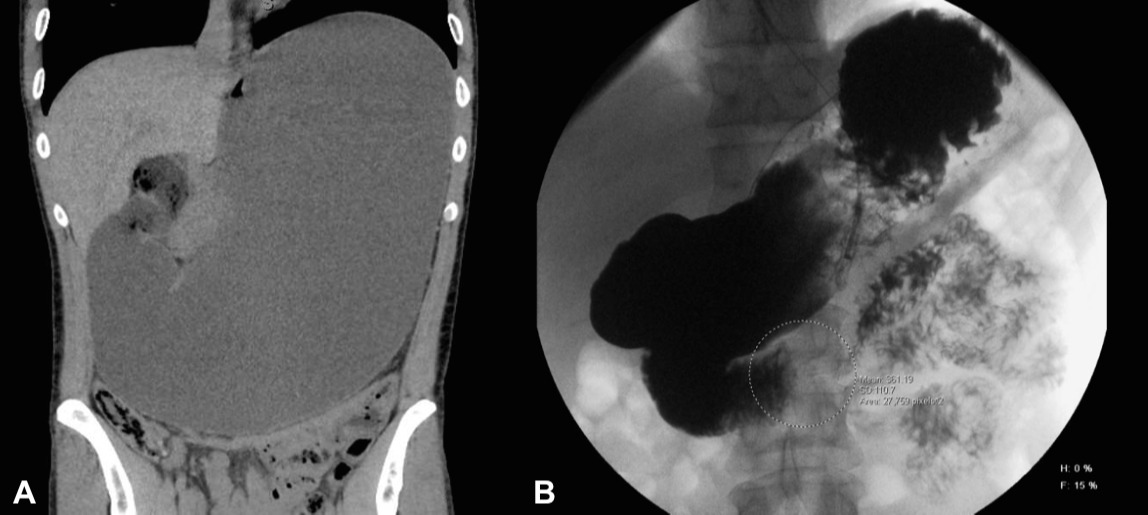Sunday Poster Session
Category: Small Intestine
P1262 - Duodenal Obstruction Secondary to Superior Mesenteric Artery Syndrome
Sunday, October 22, 2023
3:30 PM - 7:00 PM PT
Location: Exhibit Hall

Has Audio

Edward Cay, DO
Spectrum Health Lakeland
St. Joseph, MI
Presenting Author(s)
Edward Cay, DO1, Joshua Steele, DO2, Claire Hamman, DO2, Mariquit Sendelbach, DO2
1Spectrum Health Lakeland, St. Joseph, MI; 2Beaumont Health, Farmington Hills, MI
Introduction: Superior mesenteric artery (SMA) syndrome is defined by intestinal obstruction due to compression of the third portion of the duodenum between the aorta and superior mesenteric artery. Delay in diagnosis may result in complications such as obstructing duodenal bezoar or gastric perforation.
Case Description/Methods: A 39 year-old man with a history of opioid use disorder presented with diffuse abdominal pain, nausea and vomiting for 12 hours. His surgical history was unremarkable. Physical exam was notable for a BMI of 24 and a nondistended tender abdomen without rebound tenderness. CT scan showed evidence of severe gastric distension and small bowel decompression distal to the duodenum. Nasogastric tube was placed with immediate removal of 3.7 L fluid.
After improvement of symptoms with gastric decompression, an upper GI series revealed an abrupt interruption of contrast at the third part of the duodenum concerning for SMA syndrome. EGD was performed, showing LA grade A esophagitis, erosive gastropathy and no signs of masses or strictures causing obstruction up to the third part of the duodenum. The patient later underwent open duodenojejunostomy. During the surgery, there was noted to be an unusual and prominent adhesive band of tissue over the second portion of the duodenum that was lysed and may have been causing the patient’s chronic obstructive symptoms.
Discussion: SMA syndrome has an estimated incidence of 0.1%, typically occurring in ages 10 to 39 years old. A mesenteric fat pad between the aorta and SMA creates a aortomesenteric angle of 38 to 65 degrees, which correlates with BMI. This angle is decreased with fat pad atrophy, causing duodenal compression.
The most prominent risk factor is substantial weight loss, such as from trauma, anorexia nervosa, bariatric surgery, or malabsorptive conditions. Other associated conditions include drug abuse, peritoneal adhesions, and congenitally short ligament of Treitz.
Abdominal pain is relieved laying prone or in left lateral decubitus position, which increases the aortomesenteric angle. CT and upper GI series can aid in diagnosis, and endoscopy can be utilized to rule out other causes of duodenal compression.
Initial management includes fluid and electrolyte resuscitation and gastric decompression. Nutritional rehabilitation, including nasojejunal feeding tube or hyperalimentation, may restore weight and increase the mesenteric fat pad to relieve symptoms. Surgical correction is typically competed by duodenojejunostomy.

Disclosures:
Edward Cay, DO1, Joshua Steele, DO2, Claire Hamman, DO2, Mariquit Sendelbach, DO2. P1262 - Duodenal Obstruction Secondary to Superior Mesenteric Artery Syndrome, ACG 2023 Annual Scientific Meeting Abstracts. Vancouver, BC, Canada: American College of Gastroenterology.
1Spectrum Health Lakeland, St. Joseph, MI; 2Beaumont Health, Farmington Hills, MI
Introduction: Superior mesenteric artery (SMA) syndrome is defined by intestinal obstruction due to compression of the third portion of the duodenum between the aorta and superior mesenteric artery. Delay in diagnosis may result in complications such as obstructing duodenal bezoar or gastric perforation.
Case Description/Methods: A 39 year-old man with a history of opioid use disorder presented with diffuse abdominal pain, nausea and vomiting for 12 hours. His surgical history was unremarkable. Physical exam was notable for a BMI of 24 and a nondistended tender abdomen without rebound tenderness. CT scan showed evidence of severe gastric distension and small bowel decompression distal to the duodenum. Nasogastric tube was placed with immediate removal of 3.7 L fluid.
After improvement of symptoms with gastric decompression, an upper GI series revealed an abrupt interruption of contrast at the third part of the duodenum concerning for SMA syndrome. EGD was performed, showing LA grade A esophagitis, erosive gastropathy and no signs of masses or strictures causing obstruction up to the third part of the duodenum. The patient later underwent open duodenojejunostomy. During the surgery, there was noted to be an unusual and prominent adhesive band of tissue over the second portion of the duodenum that was lysed and may have been causing the patient’s chronic obstructive symptoms.
Discussion: SMA syndrome has an estimated incidence of 0.1%, typically occurring in ages 10 to 39 years old. A mesenteric fat pad between the aorta and SMA creates a aortomesenteric angle of 38 to 65 degrees, which correlates with BMI. This angle is decreased with fat pad atrophy, causing duodenal compression.
The most prominent risk factor is substantial weight loss, such as from trauma, anorexia nervosa, bariatric surgery, or malabsorptive conditions. Other associated conditions include drug abuse, peritoneal adhesions, and congenitally short ligament of Treitz.
Abdominal pain is relieved laying prone or in left lateral decubitus position, which increases the aortomesenteric angle. CT and upper GI series can aid in diagnosis, and endoscopy can be utilized to rule out other causes of duodenal compression.
Initial management includes fluid and electrolyte resuscitation and gastric decompression. Nutritional rehabilitation, including nasojejunal feeding tube or hyperalimentation, may restore weight and increase the mesenteric fat pad to relieve symptoms. Surgical correction is typically competed by duodenojejunostomy.

Figure: Figure 1. Computed tomography showing severe gastric distension (A). Upper gastrointestinal series with abrupt interruption of contrast at the third part of the duodenum consistent with superior mesenteric artery syndrome (B).
Disclosures:
Edward Cay indicated no relevant financial relationships.
Joshua Steele indicated no relevant financial relationships.
Claire Hamman indicated no relevant financial relationships.
Mariquit Sendelbach indicated no relevant financial relationships.
Edward Cay, DO1, Joshua Steele, DO2, Claire Hamman, DO2, Mariquit Sendelbach, DO2. P1262 - Duodenal Obstruction Secondary to Superior Mesenteric Artery Syndrome, ACG 2023 Annual Scientific Meeting Abstracts. Vancouver, BC, Canada: American College of Gastroenterology.
